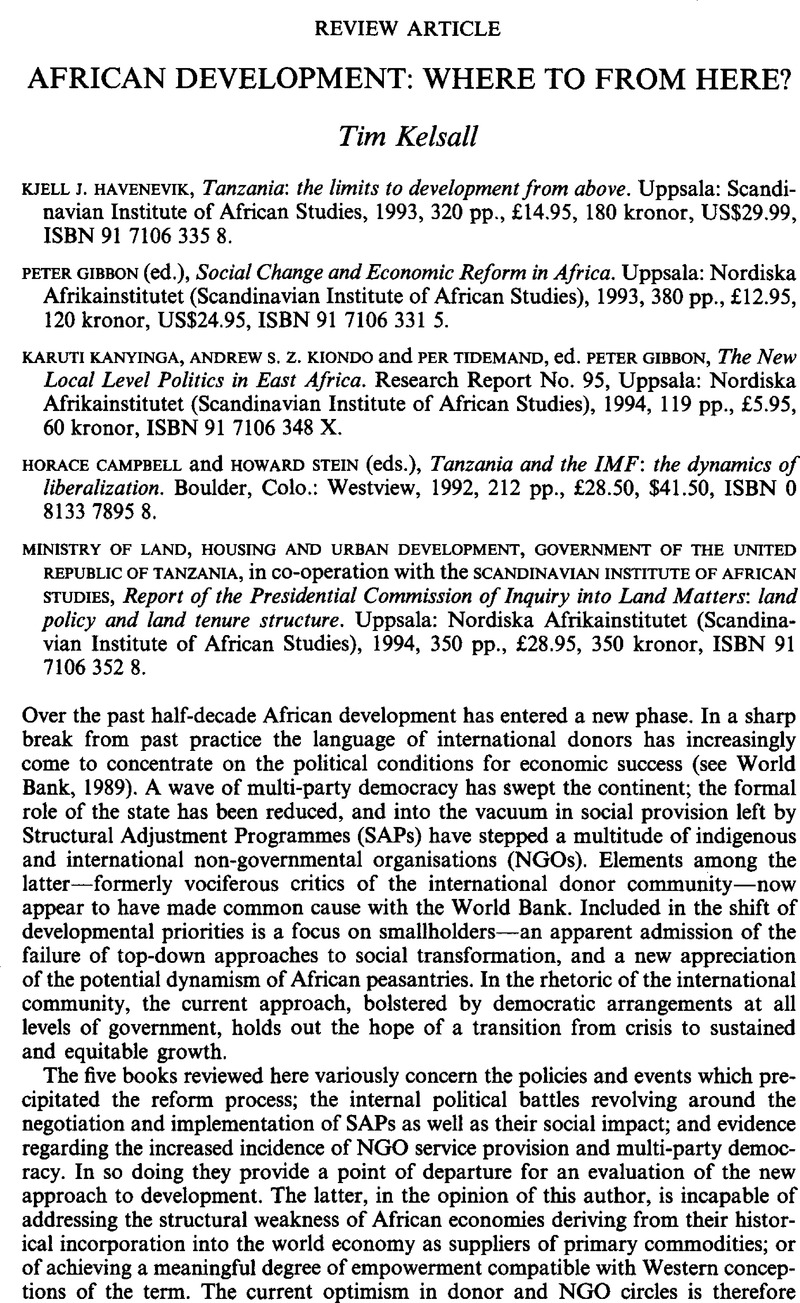No CrossRef data available.
Article contents
African development: where to from here?
Published online by Cambridge University Press: 07 December 2011
Abstract
An abstract is not available for this content so a preview has been provided. Please use the Get access link above for information on how to access this content.

- Type
- Review Article
- Information
- Copyright
- Copyright © International African Institute 1995
References
Amsden, A. H. 1990. ‘Third World industrialisation: “global Fordism” or a new model?’ New Left Review 182, 5–31.Google Scholar
Berry, S. 1985. Fathers work for their Sons: accumulation, mobility, and class formation in an extended Yoruba community. Berkeley and Los Angeles: University of California Press.CrossRefGoogle Scholar
Berry, S. 1993. No Condition is Permanent: the social dynamics of agrarian change in subSaharan Africa. Madison, Wis.: University of Wisconsin Press.Google Scholar
Bienen, H. 1970. Tanzania: party transformation and economic development, second edition. Princeton N.J.: Princeton University Press.Google Scholar
Chabal, P. 1992. Power in Africa: an essay in political interpretation. London: Macmillan.CrossRefGoogle Scholar
Cornia, G. A., van der Hoeven, R., and Mkandawire, T. 1992. ‘Overview of an alter-native long-term development strategy’, in Cornia, G. A.Hoeven, R. van der and Mkandawire, T. (eds.), Africa's Recovery in the 1990s: from stagnation and adjustment to human development. New York: St Martin's Press, for UNICEF.Google Scholar
Feierman, S. 1990. Peasant Intellectuals: anthropology and history in Tanzania. Madison, Wis.: University of Wisconsin Press.Google Scholar
Finucane, J. R. 1974. Rural Development and Bureaucracy in Tanzania: the case of Mwanza Region. Uppsala: Scandinavian Institute of African Studies.Google Scholar
Gibbon, P., Havnevik, K. J., and Hermele, K. 1993. A Blighted Harvest; the World Bank and African agriculture in the 1980s. London: James Currey.Google Scholar
Hartmann, J. 1991. ‘The two Arusha Declarations’, in Hartmann, J. (ed.), Rethinking the Arusha Declaration. Copenhagen: Centre for Development Research.Google Scholar
Heyer, J., and Williams, G. 1992. ‘OXFAM submission to Tanzanian Land Commission: agricultural issues’.Google Scholar
Heyer, J., Roberts, P., and Williams, G. (eds.) 1981. Rural Development in Tropical Africa. London: Macmillan.CrossRefGoogle Scholar
Holmquist, F. 1984. ‘Tanzania's retreat from statism in the countryside’, Africa Today 30 (4), 23–36.Google Scholar
Hyden, G. 1983. No Short Cuts to Progress: African development management in perspective. London: Heinemann.Google Scholar
Ingle, C. 1972. From Village to State in Tanzania: the politics of rural development. Ithaca N.Y.: Cornell University Press.Google Scholar
Jamal, V., and Weeks, J. 1993. Africa Misunderstood, or, Whatever happened to the rural-urban gapi London: Macmillan.Google Scholar
Jeffries, R. 1993. ‘The state, structural adjustment and good government in Africa’, Journal of Commonwealth and Comparative Politics 31 (1), 20–35.CrossRefGoogle Scholar
Kiondo, A. S. Z. 1989. ‘The Politics of Economic Reform in Tanzania, 1977-78’. Unpublished Ph.D. thesis, University of Toronto.Google Scholar
Leonard, D. 1987. ‘The political realities of African management’, World Development 15 (7), 899–910.CrossRefGoogle Scholar
Mackenzie, F. 1990. ‘Gender and land rights in Murang'a District, Kenya’, Journal of Peasant Studies 17 (4), 609–43.Google Scholar
Migot-Adholla, S. E. 1975. ‘The politics of a growers’ co-operative union’, in L. Cliffe, P.Lawrence, W.Luttrell, S. E., Migot-Adholla and Saul, J. S., Rural Co-operation in Tanzania. Dar es Salaam: Tanzania Publishing House.Google Scholar
Moore, S. F. 1986. Social Facts and Fabrications: customary law on Kilimanjaro, 1880-1980. Cambridge: Cambridge University Press.Google Scholar
Netting, R. McC. 1993. Smallholders, Householders: farm families and the ecology of intensive, sustainable agriculture. Stanford, Cal.: Stanford University Press.Google Scholar
Nyerere, J. 1968. ‘Freedom and Development’. Paper presented to the TANU National Executive Committee, October. Reprinted in Coulson, A. (ed.), African Socialism in Practice. Nottingham: Russell Press.Google Scholar
Pratt, C. 1976. The Critical Phase in Tanzania, 1945-68: Nyerere and the adoption of a socialist strategy. Cambridge: Cambridge University Press.Google Scholar
Sender, J., and Smith, S. 1990. Poverty, Class and Gender in Africa: Tanzanian case study. London: Routledge.Google Scholar
Shipton, P. 1988. ‘The Kenyan land tenure reform: misunderstandings in the public creation of private property’, in Downs, R. E. and Reyna, S. P. (eds.), Land and Society in Contemporary Africa. Hanover N.J.: University Press of New England.Google Scholar
Sorrenson, M. P. K. 1967. Land Reform in the Kikuyu Country. Nairobi: Oxford University Press.Google Scholar
Thoden van Velzen, H. U. E. (1973) ‘Staff, kulaks, peasants: the study of a political field’, in Cliffe, L. and Saul, J. (eds.), Socialism in Tanzania; an interdisciplinary reader II. Dar es Salaam: East Africa Publishing House.Google Scholar
United Nations Economic Commission on Africa. 1989. African Alternative Framework to Structural Adjustment Programmes for Socio-economic Recovery and Transformation. Addis Ababa: Economic Commission on Africa.Google Scholar
Van Cranenburgh, O. 1990. The Widening Gyre: the Tanzanian one-party state and policy towards rural co-operatives. Delft and Leiden: Eburon.Google Scholar
Van der Hoeven, R. 1992. ‘External dependence and long-term development’, in Cornia, G. A.Hoeven, R. van der and Mkandawire, T., Africa's Recovery in the 1990s: from stagnation and adjustment to human development. New York: St Martin's Press, for UNICEF.Google Scholar
World Bank. 1989. Sub-Saharan Africa: from crisis to sustainable growth. Washington D. C.: World Bank.Google Scholar




